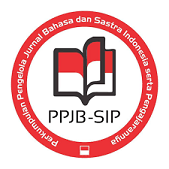PEMOSISIAN DAN PENCITRAAN AKTOR BERITA-BERITA RENCANA REKLAMASI TELUK BENOA DALAM BALI POST
DOI:
https://doi.org/10.23887/jjpbs.v4i2.7869Abstract
Penelitian ini bertujuan untuk (1) Mendeskripsikan dan menganalisis pemosisian aktor dalam pemberitaan rencana reklamasi Teluk Benoa dalam Bali Post dan (2) mendeskripsikan dan menganalisis pencitraan aktor dalam pemberitaan rencana reklamasi Teluk Benoa dalam Bali Post. Penelitian dengan rancangan penelitian deskriptif kualitatif ini menggunakan berita-berita rencana reklamasi Teluk Benoa dalam harian Bali Post sebagai subjek penelitian. Lingkup penelitian ini hanya pada berita Bali Post yang memuat berita- berita rencana reklamasi Teluk Benoa sejak Januari sampai April 2015. Sementara itu, objek penelitian ini adalah pemosisian dan pencintraan aktor dalam pemberitaan rencana reklamasi Teluk Benoa dalam harian Bali Post. Metode pengumpulan data yang digunakan adalah metode dokumentasi dengan teknik baca-catat. Data yang diperoleh dianalisis dengan menggunakan teknik analisis deskriptif kualitatif mengikuti teknik analisis Miles dan Huberman. Hasil penelitian ini menunjukkan bahwa dalam pemosisian aktor Bali Post menggunakan strategi eksklusi dengan uraian 6 pasivasi; 3 nominalisasi serta strategi inklusi dengan uraian 5 diferensiasi; 2 abstraksi; 6 identifikasi; 12 indeterminasi-; 8 asimilasi; dan 5 asosiasi. Dari pemosisian tersebut dapat diketahui bahwa aktor yang dianggap menolak reklamasi mendapatkan citra yang positif dan aktor yang proreklamasi mendapatkan citra yang negatif.Kata Kunci : reklamasi Teluk Benoa; eksklusi; inklusi; pemosisian; pencitraan
This research was aimed to (1) describe and analyze the positioning of the actor in reclamation planning of Teluk Benoa news in Bali Post and (2) describe and analyze actor’s image in reclamation planning of Teluk Benoa news which was existed in Bali Post. This qualitative descriptive research used news of Teluk Benoa reclamation planning which were existed in daily news of Bali post as the subject of the research. Scope of this research was only related to news of Teluk Benoa reclamation planning which were published since January to April 2015. Meanwhile, object of this research was actor’s positioning and imaging which was much related to the news. Documentation was the method used in collecting the data which was done using reading-taking note technique. The data was analyzed by using qualitative descriptive technique which adopt Miles and Huberman’s analysis technique. This result of the research showed that in actor’s positioning, Bali Post used exclusion strategy which included 6 passivations, 3 nominalizations, additionally, inclusion strategy including 5 differentiation, 2 abstraction, 6 identification, 12 indeterminacy, 8 assimilation, and 5 association. From those positioning, it can be concluded that actor who refused reclamation got positive image and those who accepted reclamation got negative image.
keyword : Teluk Benoa reclamation; exclusion, inclusion, positioning, imaging
Published
2016-07-26
Issue
Section
Articles
License
Authors who publish with the Jurnal Pendidikan Bahasa dan Sastra Indonesia Undiksha agree to the following terms:- Authors retain copyright and grant the journal the right of first publication with the work simultaneously licensed under a Creative Commons Attribution License (CC BY-SA 4.0) that allows others to share the work with an acknowledgment of the work's authorship and initial publication in this journal
- Authors are able to enter into separate, additional contractual arrangements for the non-exclusive distribution of the journal's published version of the work (e.g., post it to an institutional repository or publish it in a book), with an acknowledgment of its initial publication in this journal.
- Authors are permitted and encouraged to post their work online (e.g., in institutional repositories or on their website) prior to and during the submission process, as it can lead to productive exchanges, as well as earlier and greater citation of published work. (See The Effect of Open Access)







